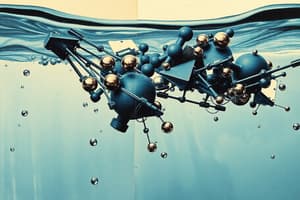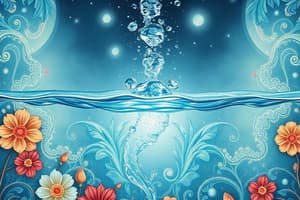Podcast
Questions and Answers
Water is made up of _______ atom of oxygen and _______ atoms of __________.
Water is made up of _______ atom of oxygen and _______ atoms of __________.
one; two; hydrogen
Water molecules are _______ which gives the end bearing the oxygen atom a slightly __________ charge and the hydrogen atoms are slightly ______ in charge.
Water molecules are _______ which gives the end bearing the oxygen atom a slightly __________ charge and the hydrogen atoms are slightly ______ in charge.
polar covalent; negative; positive
_________ bonds form between water molecules.
_________ bonds form between water molecules.
Hydrogen
Each water molecule can form a maximum of ______ hydrogen bonds at a time.
Each water molecule can form a maximum of ______ hydrogen bonds at a time.
______________________ is the linking of like molecules. Think of this property as a 'water strider' walking on top of a pond due to _______________ tension created by hydrogen bonding between water molecules.
______________________ is the linking of like molecules. Think of this property as a 'water strider' walking on top of a pond due to _______________ tension created by hydrogen bonding between water molecules.
__________________ is the clinging of one substance to another. Think of water adhering to another substance like the sides of a glass or a windshield.
__________________ is the clinging of one substance to another. Think of water adhering to another substance like the sides of a glass or a windshield.
______________ is the movement of water molecules up a very thin tube called stomata and their evaporation from the stomates in plants. The water molecules cling to each other by ____________ and the walls of the xylem by _________.
______________ is the movement of water molecules up a very thin tube called stomata and their evaporation from the stomates in plants. The water molecules cling to each other by ____________ and the walls of the xylem by _________.
Moderation of ___________ is possible because of water's high specific heat.
Moderation of ___________ is possible because of water's high specific heat.
Specific heat is the amount of heat required to ________ or lower the temperature of a substance _________ degrees Celsius. Relative to most other materials, the temperature of water changes less when a given amount of heat is lost or __________. The high specific heat of water makes the Earth's oceans relatively _______ and able to support ______ quantities of life.
Specific heat is the amount of heat required to ________ or lower the temperature of a substance _________ degrees Celsius. Relative to most other materials, the temperature of water changes less when a given amount of heat is lost or __________. The high specific heat of water makes the Earth's oceans relatively _______ and able to support ______ quantities of life.
______________ of bodies of water by floating ice.
______________ of bodies of water by floating ice.
Water is less _________ as a solid than a liquid which is opposite of most other substances. Since ice is less _____ it will float. This keeps large bodies of water from ________ and moderates the ______.
Water is less _________ as a solid than a liquid which is opposite of most other substances. Since ice is less _____ it will float. This keeps large bodies of water from ________ and moderates the ______.
Water is an important _________________. (A substance something dissolves in).
Water is an important _________________. (A substance something dissolves in).
_________________ substances are water-soluble. These include IONIC compounds, _____________ molecules like sugar and some proteins.
_________________ substances are water-soluble. These include IONIC compounds, _____________ molecules like sugar and some proteins.
_______ substances like oils are nonpolar and will not _____ in water.
_______ substances like oils are nonpolar and will not _____ in water.
The pH scale runs between _______ and ______ and measures relative _______ and ______ of aqueous solutions.
The pH scale runs between _______ and ______ and measures relative _______ and ______ of aqueous solutions.
Acids have an excess of ______ ions and a pH below ______.
Acids have an excess of ______ ions and a pH below ______.
_________ have an excess of ________ ions and a pH above ________.
_________ have an excess of ________ ions and a pH above ________.
Pure water is ______ which means has a pH of ______.
Pure water is ______ which means has a pH of ______.
Buffers are substances that minimize changes in the _______. They accept ______ from solutions when they are in excess and donate _____ when they are depleted.
Buffers are substances that minimize changes in the _______. They accept ______ from solutions when they are in excess and donate _____ when they are depleted.
Carbonic acid (_________) is an important buffer in living systems. It moderates pH changes in _______ plasma and the ______.
Carbonic acid (_________) is an important buffer in living systems. It moderates pH changes in _______ plasma and the ______.
Flashcards are hidden until you start studying
Study Notes
Structure and Properties of Water
- Water consists of one oxygen atom and two hydrogen atoms.
- The molecule is polar covalent, with a slightly negative charge on the oxygen and a slightly positive charge on the hydrogens.
Hydrogen Bonds
- Hydrogen bonds form between water molecules.
- Each water molecule can create a maximum of two hydrogen bonds.
Unique Properties of Water
- Cohesion: The linking of like molecules allows phenomena such as surface tension, enabling insects like the water strider to walk on water.
- Adhesion: The attraction of water molecules to different substances, illustrated by water’s ability to stick to glass or a windshield.
- Transpiration: The process where water moves through plants, aided by cohesion among water molecules and adhesion to xylem walls.
Temperature Regulation
- High specific heat of water enables moderation of temperature changes, which supports stable ecosystems.
- Specific heat refers to the amount of heat necessary to change a substance's temperature by one degree Celsius; water's temperature fluctuates less than many other materials.
Ice Density and Insulation
- Water is less dense as a solid (ice) than as a liquid, causing ice to float and providing insulation for aquatic environments, ensuring they do not freeze solid.
Solvent Properties
- Water is a crucial solvent, dissolving various substances.
- Hydrophilic substances, including ionic compounds and non-ionic polar molecules like sugar, easily dissolve in water.
- Hydrophobic substances, such as oils, are nonpolar and do not dissolve in water.
pH Scale
- Measures acidity or alkalinity within a range of 0 to 14.
- Acids increase hydronium ions with a pH below 7.
- Bases increase hydroxide ions with a pH above 7.
- Pure water is neutral, having a pH of 7.
Buffer Systems
- Buffers minimize pH changes by accepting excess H+ ions and donating H+ when depletions occur.
- Carbonic acid (H2CO3) serves as a significant buffer in biological systems, regulating pH in blood and ocean water.
Studying That Suits You
Use AI to generate personalized quizzes and flashcards to suit your learning preferences.



